The core of this article originally appeared in the print edition of Seattle’s Westside Weekly, but has not appeared online until now. However, this is much, much expanded. It represents the culmination of two years of research. Along the way I’ve written a number of articles subtitled “a Tradewell story”. This is THE Tradewell story that I’ve been slowly working towards.
tl;dr:
There is a grocery store building in Burien that was designed so well that it won a national American Institute of Architects award in the late 1950s. Today, very few remember what the store at 236 SW 152nd Street once was.
The original article
In February 1957 Tradewell unveiled a new supermarket in Burien. Its award-winning architecture was stunning to the community and meant to be the prototype for a wave of buildings for the chain across the West.
Let’s back up for a second. It’s tough to see today but this is a very pretty building — ignoring the modified signage, painted windows and ceiling insulation. The 1957 photo shows an everyday example of Modern architecture. Its unadorned, exposed structure is transparent and open and uses honest materials of glass, steel and concrete.
The architect for the building was UW-trained Welton Becket. He split for Los Angeles early in his career and is mostly remembered for work there like the Capitol Records Building and the plan for Century City. Becket’s firm designed a number of stores for Tradewell in Seattle including Crown Hill, Wedgwood and White Center just before and after 1957.
For the Burien store and its three offspring Becket partnered with Richard Bradshaw, L.A.’s expert on thin-shell structural engineering. Bradshaw’s unique talents let Tradewell’s arched vaults soar from the front to rear of the store with few supports. Bradshaw was trailblazing fashionable markets that struck the bulls-eye with chain grocers’ target demographic of young, suburban housewives. For example he designed an arched grocery for King Cole Markets in L.A. as early as 1950, and had just completed designs for a wild parabolic domed supermarket in Oahu, Hawaii.
When the American Institute of Architects awarded Tradewell’s Burien store a National Award of Merit in May 1959, former Tradewell exec Monte L. Bean must have felt vindicated. In 1939 – the depths of the Great Depression – he was hired to salvage four deeply indebted grocery chains in Seattle. He rebranded them Tradewell and turned them into a mammoth. The deal was he ran the place his way or not at all. So when Tradewell’s corporate parent began rejecting Bean’s new store proposals in 1958 and Safeway built on those properties one-by-one, Bean quit. He had only gotten four of his Burien designs built.
The Burien Tradewell appears to be the only supermarket to ever win an AIA national award. Bean intended to build 30 more stores on the Burien model. Instead Safeway’s Modernist design swept across the region. In 1959 they responded to Tradewell with a barrel-arched prototype store in the Marina district of San Francisco. “Marina,” rather than “Burien,” would become synonymous with Modern supermarkets in America.
Tradewell, the too long
“Your new Burien Tradewell is not only the ‘prettiest’, but the most efficient store I’ve ever seen. Shopping here is going to be nothing but a pleasure for the home-maker, and the men of the family, too. No words can describe this new Tradewell, for it’s just something never seen before.” (Credited to R. Ragland, Manager in February 11, 1957 advertisement in Seattle Times.)
“A strikingly designed, vaulted roof of thin shell concrete extends to cover the walkway and over 23,700 square feet of area inside. This vast shopping area is more than ample for all of your food requirements. A new trademark, the Tradewell ‘T’, symbol of quality, rises above the building on twin steel columns.” (More copy from the February 11, 1957 Seattle Times ad.)
“We predict the Burien Tradewell will be the style-setter in customer convenience, employee comfort and market architecture for years to come.” (M. L. Bean letter published in February 11, 1957 Seattle Times.)
Tradewell Stores started in October 1939 as the the relaunch of several chains in Seattle. The oldest was Augustine & Kyer, founded in 1886 as Charles Louch – Grocer. Other antecedent chains included Eba’s Cut-Rate Markets, Mutual Groceries, United Groceries, Anderson Food Stores, and Piggly Wiggly of Washington. Circumstantial evidence indicates that two Tradewell markets owned by Harold L. Cohen were also merged into the chain and gave it its name. (The links in this paragraph lead to articles I’ve written exploring various facets of Tradewell’s origins.)
Pacific Gamble Robinson was a major Pacific Northwest grocery distributor during the Great Depression. By 1939 they had accumulated control of many groceries in the Seattle area, due to seizing assets through bankruptcy. These included Augustine & Kyer, the Eba’s chain (which included former Mutual, United, Anderson and Piggly Wiggly stores), and other groceries. PGR hired former Safeway regional executive Monte L. Bean (HistoryLink biography) to turn the stores around. Bean had a long, successful background in grocery management. His career started the day he graduated college, heading to a bookkeeping job at Lorenzo Skaggs’ chain, which eventually joined Safeway. Bean consolidated the PGR stores under one umbrella, changed the name to Tradewell, and began cutting costs. His success surprised everyone except Bean himself, and the chain became a major player in the Pacific Northwest.
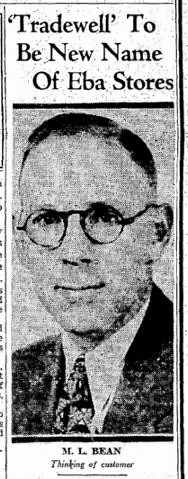
Burien as archetype and prototype
The prototype opened on Monday, February 11, 1957. Local papers had extensive coverage. One article in the Seattle Times of February 13, 1957 focused on an interesting welcoming committee. Although ads and most articles focused on the “home-maker” or housewife, Tradewell gave a special pre-opening tour to members of the Hiline Business and Professional Women’s Club (now Southwest Seattle BPW), guided by architect Welton Becket. The difficult situation for women in the 1950s is made clear in the article, however, as it names opening day ribbon-cutter “Mrs. Paul Knell” as if she did not have her own name. It praised these working women for their good work in the community organizing blood drives and sponsoring orphans and rest homes.
While these are truly praiseworthy, they’re also the activities that housewives had been involved in for decades. Finally they were described as “Women who own their own businesses or who are associated with the husbands in partnership enterprise. Other members belong to the professions or have managerial jobs in government and industry.” An article later in the issue revealed some of their work: nurse, owner of a magazine distribution company, supervisor for a mail-order business, owner of insurance brokerage across 152nd, flower shop owner, beauty salon owner.
Today it would be a normal group of women, but in 1957 it was a significant gathering of 65 hard-working women. While the language seems a bit patronizing now – especially all of them introduced as Mrs. Paul or Mrs. Norman – I think it was a significant move for Monte L. Bean to invite them. They were sure it was the first time any BPW group in the country had been invited to open a new grocery store.
The others
Burien was the prototype. There were three production models built, scaled down a bit but sharing the original concept. This was in keeping with the purpose of Becket’s design. In his statement in the Merit Award he said, “Scheme was also to be a trademark so that their markets would be quickly and favorably identified, at the same time variable in size.”
Only one of the three remains, currently Rite-Aid #5228 in Richmond Beach across from the entrance to Innis Arden at 655 NW Richmond Beach Road. It has been boxed in to match the standard commercial floor plans of a drug store.
The other two were in Kenmore at 17562 68th Ave NE, and Columbia City at 4801 Rainier Avenue S. The above rendering appeared in opening celebration materials for all three stores. Innis Arden on October 1, 1957; Kenmore on November 5, 1957; and Columbia City on February 30, 1958. Each was accompanied by a call for children to submit their drawings of the astounding building introduced into their everyday lives.
The Kenmore store was demolished at a date that is unclear to me, perhaps 1997. Apparently it was where the Rite-Aid is at 18022 68th Ave NE. Although the address differs, it would be a sensible bureaucratic change to give addresses north of Bothell Way a different block number. The Rite-Aid was built in 1998, and aerials show a flattened property that year. Perhaps that was the date of demolition. I’m sure I will find out in the near future and be able to update this page.
(UPDATE 9/15/2020: I was contacted by a long-time Kenmore resident who is the son of an employee when this store first opened. He let me know that although it has been heavily modified, the 1957 Kenmore store was not leveled in 1998. Some amount of the original store was kept. Looking back at the 1998 aerial photo, I think I can see a shadow of the north wall at least.)
It is no coincidence that two of the sites are now Rite-Aids. Monte L. Bean started a drugstore chain of his own named Pay’n’Save, and placed stores next to each of the Tradewells that he operated for PGR. Bean also created a corporate parent for Pay’n’Save that eventually encompassed a large array of retail chains including Lamont’s clothing and Schuck’s automotive. This corporation must have purchased the two former Tradewell sites which were adjacent to its smaller drug stores to upgrade. Pay’n’Save drugstores were purchased by Payless in 1988, and Payless was in turn purchased by Rite-Aid in 1996.
The Columbia City store was destroyed in 2013. It survived until then with the front glass completely replaced with walls, the arches cut off and the facade ringed by a burgundy awning. It was a Tradewell until at least 1987, and operated as a grocery store by Associated Grocers until early 1992. It was then converted into Columbia Plaza, which contained a number of small retail tenants. The final state is chronicled from page 13 of a report prepared in 2008 by BOLA Architecture + Planning. Like the Burien prototype, its back provided the only real reminder of the original design, shown on page 16.
The architecture
After reviewing the online American Institute of Architects award database, I believe that this is the only grocery store to ever win a merit or honor award from them. The basic award details are available on the Department of Archealogy & Historical Preservation website. The award was given in 1959 for Merit in architecture to Welton Becket and Associates.
Leading up to the award, the September 1958 edition of Progressive Architecture included a spread of photos of the Burien Tradewell which accompanied a long essay on the needs, use and technology of light. Several pages of philosophical discussion set the stage: “As intangible as the inner space itself, light and only light can enter where bricks and steel cannot. Since light is not obvious, like wood, its potential has never been fully realized. It is, nevertheless, a building material. The most difficult medium of all to work with, because it is intangible, light is the only material which can shape space directly without replacing it. It can fill it without filling.”
Photos of Tradewell preceded the essay with the description,
“This supermarket in Burien, Washington, was designed as a prototype for possibly 30 additional units to be built in the Tradewell chain. Hence, an important design goal, in addition to providing an efficient plan solution, was to develop a readily identifiable symbol that would immediately register ‘Tradewell’ in the public mind. This is apparent in every aspect of the building – in the plan scheme, in the structural system, in sign co-ordination, in the lighting. The night view demonstrates how effective the combination of distinctive structural form and high-level lighting is in creating an arresting beacon…
“The economical structure employs common materials in an uncommon way. The steel frame, left exposed, is painted brilliant orange; thin-shell concrete forms the 8-bay, barrel-vaulted roof, with 12-ft overhangs providing covered walkways. Filler walls are glass, concrete block, or stone masonry. A focal point is a “bow tie” bracing panel of blue porcelain enamel on aluminum.
“The functional lighting system has an intensity of 60 feetcandles. Fixture brackets occur on beam extensions where the roof vaults join. These brackets, spaced 10 ft o.c., support bowed-steel arms, from which fluorescent fixtures with plastic edging are suspended on cantilevered, pressed-steel channels that also serve as wiring raceways. (Lighting is Architecture: Development of Function, Progressive Architecture, September 1958, p. 137)

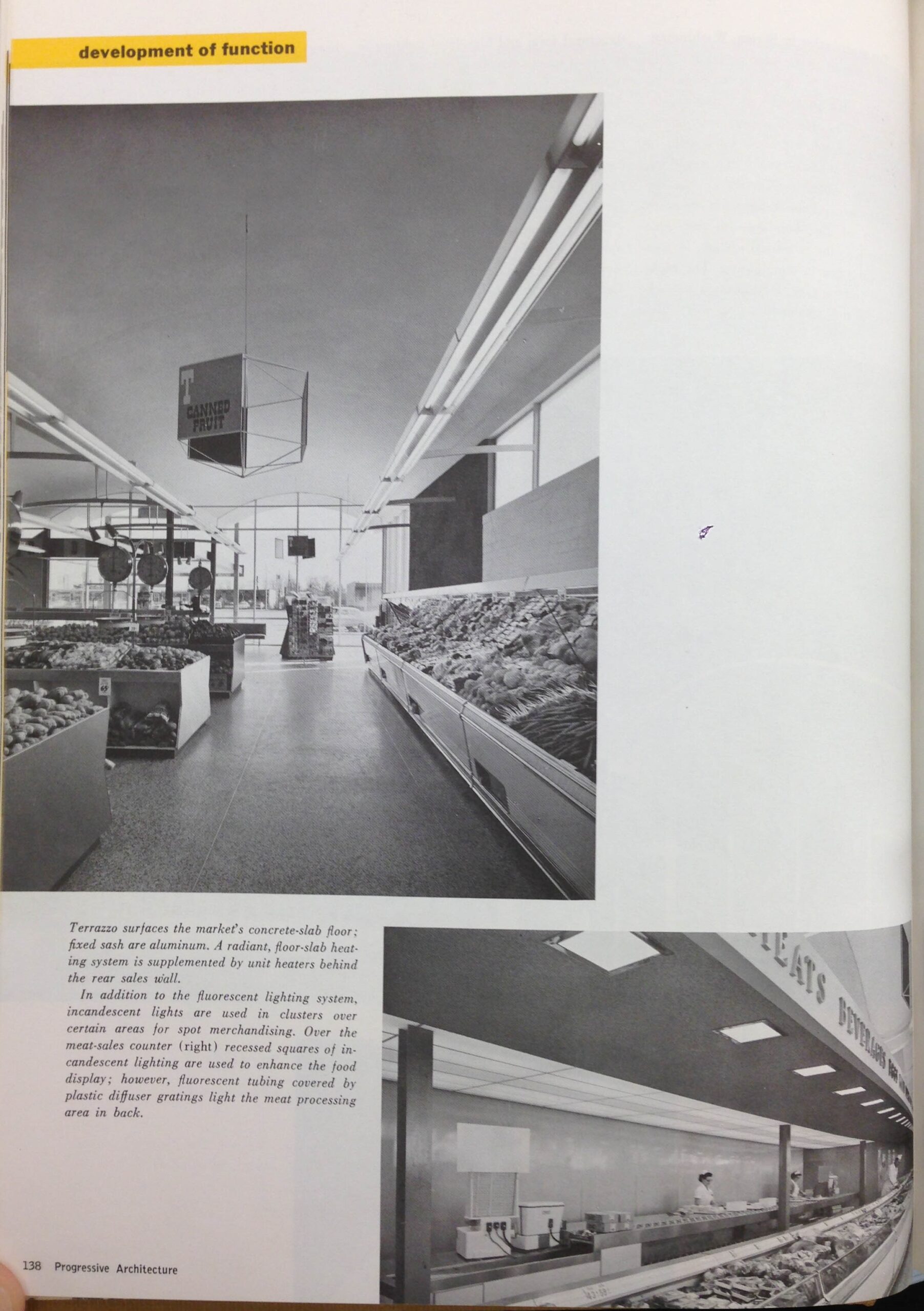
The architect
I did a bit of a full circle recently. My Tradewell research has led me to look at many aspects of Seattle’s early grocery history. In December I wrote a review of a short-lived building type called drive-in public markets. One of them was designed by the same architect as the Burien Tradewell prototype, Welton Becket.
In that article I described Becket’s early career:
Becket graduated from the University of Washington in June 1927, the same class as Paul Thiry. Thiry of course is remembered as the father of Pacific Northwest modernism. After graduation the two of them then traveled to Europe, studying in France and then seeing the architectural wonders. Sketches and watercolors from their trip were displayed for a time at the Henry Gallery.
n 1930 Becket passed the state architect exam and entered practice with Walter Wurdeman. Although both had worked at architects’ offices after graduation, the Cove Mid-City Market was within the first year of self-employment at least for Becket. The Seattle Times announced two projects by Becket designed in 1930: the Cove Mid-City Market announced in October; and the garage for the Meany Hotel which was announced in December. His profile at the Washington State Department of Archaeology & Historic Preservation includes several homes and a candy shop remodel as well in 1930.
The Getty archives list several more projects completed in 1931, but then only one for 1932. Due to the Great Depression, by 1933 Becket and Wurdeman were unable to find work in Seattle. They chose to move their practice to Los Angeles.
Becket and Wurdeman, and then Becket alone after Wurdeman’s death in 1949, went on to design a surprising number of the modern buildings that shaped the visual identity of Los Angeles. Just before the Burien Tradewell, Becket completed the Parker Center and Capitol Records buildings in 1955. One resource that will give you a good idea of the breadth of Becket’s career is this pamphlet Built by Becket. To reinforce my point in this article though, that pamphlet does not mention the Burien Tradewell despite it winning an AIA award.
Becket did at least one more store for Tradewell before Burien, this linear modern design in Crown Hill. It replaced a prior store at the same location, and was definitely not as long as it appears in this sketch. The site is currently a Value Village at 8532 15th NW, but the thrift store is in a building from the 1980s.
An ad in the September 13, 1956 Seattle Times for opening day said, “Designed for YOU . . . the modern American woman. Wide aisles, tremendous selection, most modern of fixtures . . . pleasing colors and lilting music. This store was created for YOUR shopping pleasure. […] You’ll be delighted by the ‘decor’ of this super-market, created by Welton Becket and Associates, world famous architects.” I haven’t yet found a contemporary photo of the Crown Hill Tradewell.
After Bean’s departure from Tradewell, Becket’s firm did at least two more restrained designs for them. One could be seen in the Wedgwood store which opened in March 1959. Several architectural elements were retained from Burien, but the arched thin shell concrete was replaced with steel triangle beam ceiling.
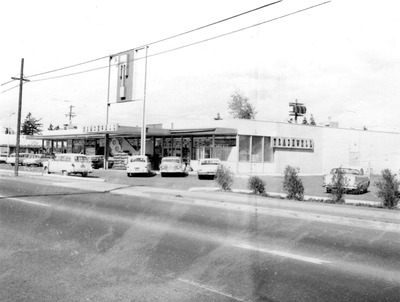
The other was repeated on at least a half dozen buildings. The first opened in 1960, with Bellevue architect John Rushmore as their local representative. All of the concepts of openness and light of Burien’s store were foresaken, leaving only the signature arches hung over the front walkway of a common box with the new trademark T sign. Although there are likely more, six known structures were built of this design starting in 1960, in Lake City at 12015 31st NE (currently an LA Fitness, facade covered with sign), Bremerton, Everett and Tacoma, and in 1961 at the southeast corner of MLK and Othello (demolished in 2009) and White Center at 9635 17th Avenue SW (currently an O’Reilly Auto Parts, a corporate descendant of Bean’s Schuck’s Auto Parts. In a departure, the awning faces the sidewalk rather than the parking lot. The awning has been covered).
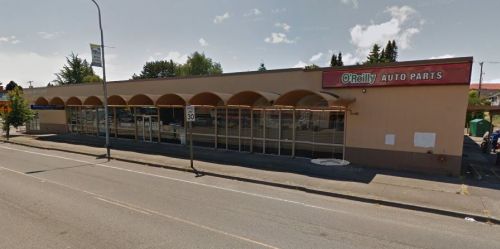
If the Tradewell stores before Burien and after Columbia City look wholly unlike the 1957 to 1958 structures, more than a bit of the credit is due to structural engineer Richard Bradshaw. Bradshaw apparently worked with Becket on a number of projects over the years, but unfortunately it does not appear to be possible to find even a partial assessment of his work online. Here is one that scratches the surface. Thin shell concrete structures were still in a state of experimentation, and engineers like Bradshaw allowed whole new classes of buildings to be constructed.
The greatest flattery
Bean’s career at Tradewell was spent locked in commercial combat with his former employer, Safeway. He had the benefit of wide lateral to run his smaller chain as he saw fit, with loose control by his management at Pacific Gamble Robinson. It was a condition of his initial employment in 1939. He would run Tradewell as if it were his own. Death and retirement of his sponsors at corporate headquarters caused his situation to change rapidly in the mid-1950s. After the Burien Tradewell opening he found his proposals for new stores challenged and refused one after another. Finally in 1959, just months before the AIA awarded Becket for his Burien design, Bean announced his retirement. Becket’s design was watered down, and the few Burien-inspired stores were left as oddities.
Meanwhile, Safeway was busy responding to the threat of the Burien Tradewell’s dynamic, modern design. In 1959 Safeway opened a new, single-arched barrel design store in the Marina District of San Francisco. It would prove to be an iconic design as Safeway continued developing it in new markets.
They came to Seattle as well, providing the image of modern supermarket that Tradewell should have filled. One example was the 1962 store in downtown Bellevue that was demolished in 2014. Another was the 1961 Crown Hill store across from Becket’s Tradewell, which was demolished for the current 1994 Safeway. The only that I’m sure is left is the 1962 store at Queen Anne Avenue North and Boston Street, but it has had its front window completely replaced with an expansive enclosure. In comparison, the Burien Tradewell has fared much better than the other local examples of the modern grocery movement it inspired.
Is this the end?
The Columbia City report cited above was paid for by the property owners hoping to show that the building had no significance. It was demolished, replaced with the Angeline Apartments with PCC Market in the first floor. Probably the building was too far gone to be saved, with the entire facade carved out and refilled. But hopefully this article provides the beginning of an understanding of what significance it really did have.
The state Department of Architectural Heritage and Preservation has identified a serious lack of post-World War Two structures that have been given protected status in Washington State. Of 19 structures that were given national AIA awards from 1954 to 1979, only one has been given protected status and two have already been destroyed. Modernism is underrepresented. Another way to look at it is that three of the 19 were commercial buildings: A Bellevue bank that was destroyed; the Weyerhauser headquarters in Federal Way which has an uncertain future; and of course the Burien Tradewell.
A close inspection of the facade shows that the Burien Tradewell is only lightly masked: paint over the top of the windows; a canvas awning hiding the scalloped concrete awning; insulation filling the ceiling form of the thin-shell concrete roof. It’s salvagable. It’s worth saving.
Hopefully you are one more reader who is convinced that the ordinary can unveil the surprising and beautiful.
More Groceries
I have a growing portfolio of writing about the history of Seattle groceries.
Here are the articles specifically related to Tradewell and its predecessors:
- Charles Louch Farm
- Augustine & Kyer
- Capitol Hill – fancy groceries since 1923 (on CHS blog)
- Piggly Wiggly Seattle
- Anderson, United and Mutual Markets
- Eba’s Cut Rate Markets
- Main Arcade Eba’s Store No 1
- Corner Market Eba’s Store No 2
- Wallingford Eba’s Store No 7
- Buy your rubber at City Market (on CHS blog)
And other grocery articles:
- Seattle’s Drive-In Markets
- Seattle’s earliest car architecture in pictures – Drive-in markets
- Ice cream, beer, and the Montlake Drive-in Public Market (on CHS blog)
- Groceteria
- (Witness Weeps) – story of Groceteria founder Alvin Monson
- Grocery revolution reaches Broadway – more on Groceteria (on CHS blog)
- A Broadway clock that tells history not time – Queen City Grocery and IGA (on CHS blog)
- Broadway Market v1.0 (on CHS blog)
- Blueprints of Broadway Market
- Piggly Wiggly on Broadway (on CHS blog)
- A shop on 11th Ave – Salle Brothers and Arai Grocery (on CHS blog)
Discover more from ba-kground
Subscribe to get the latest posts sent to your email.


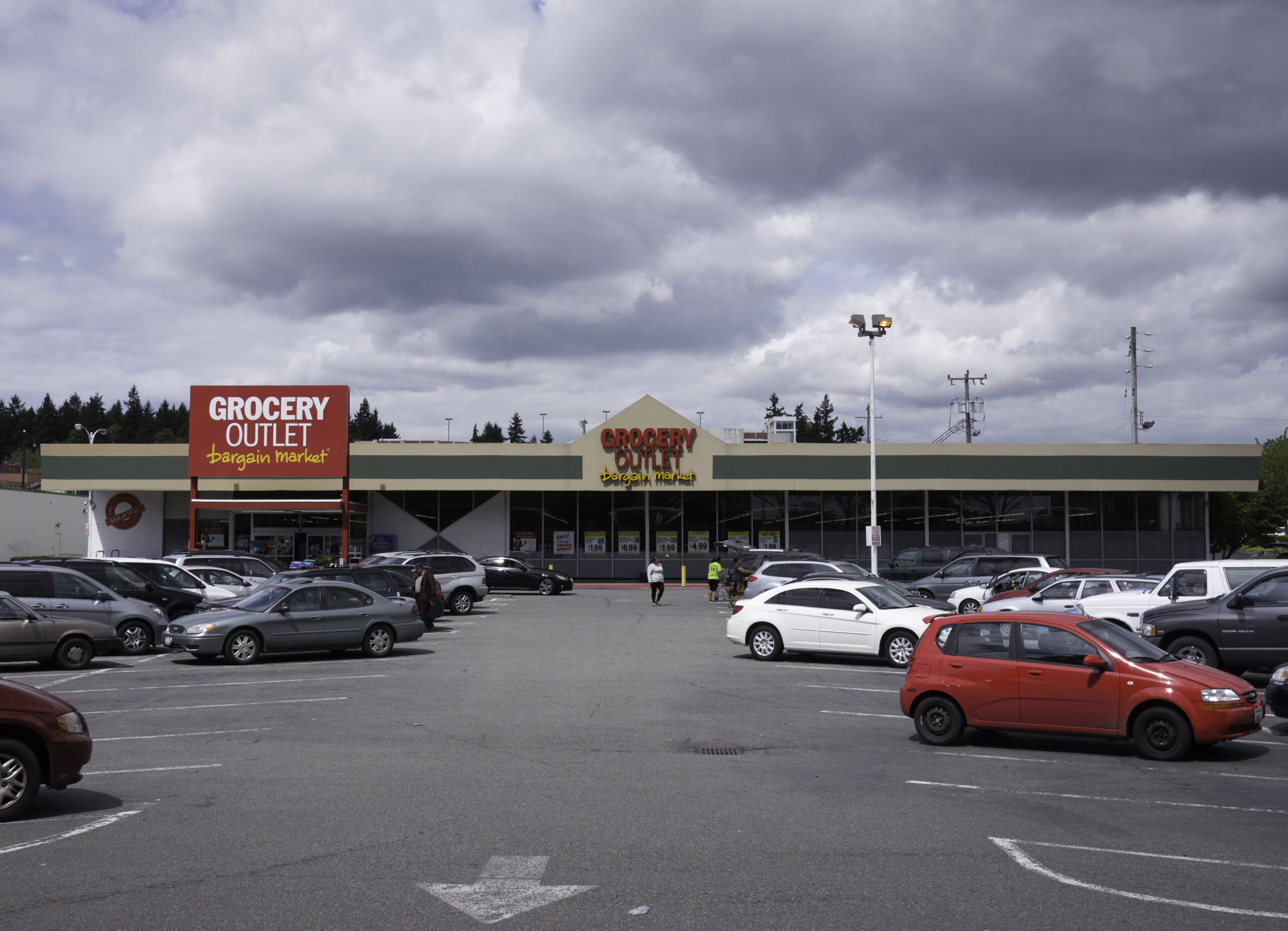
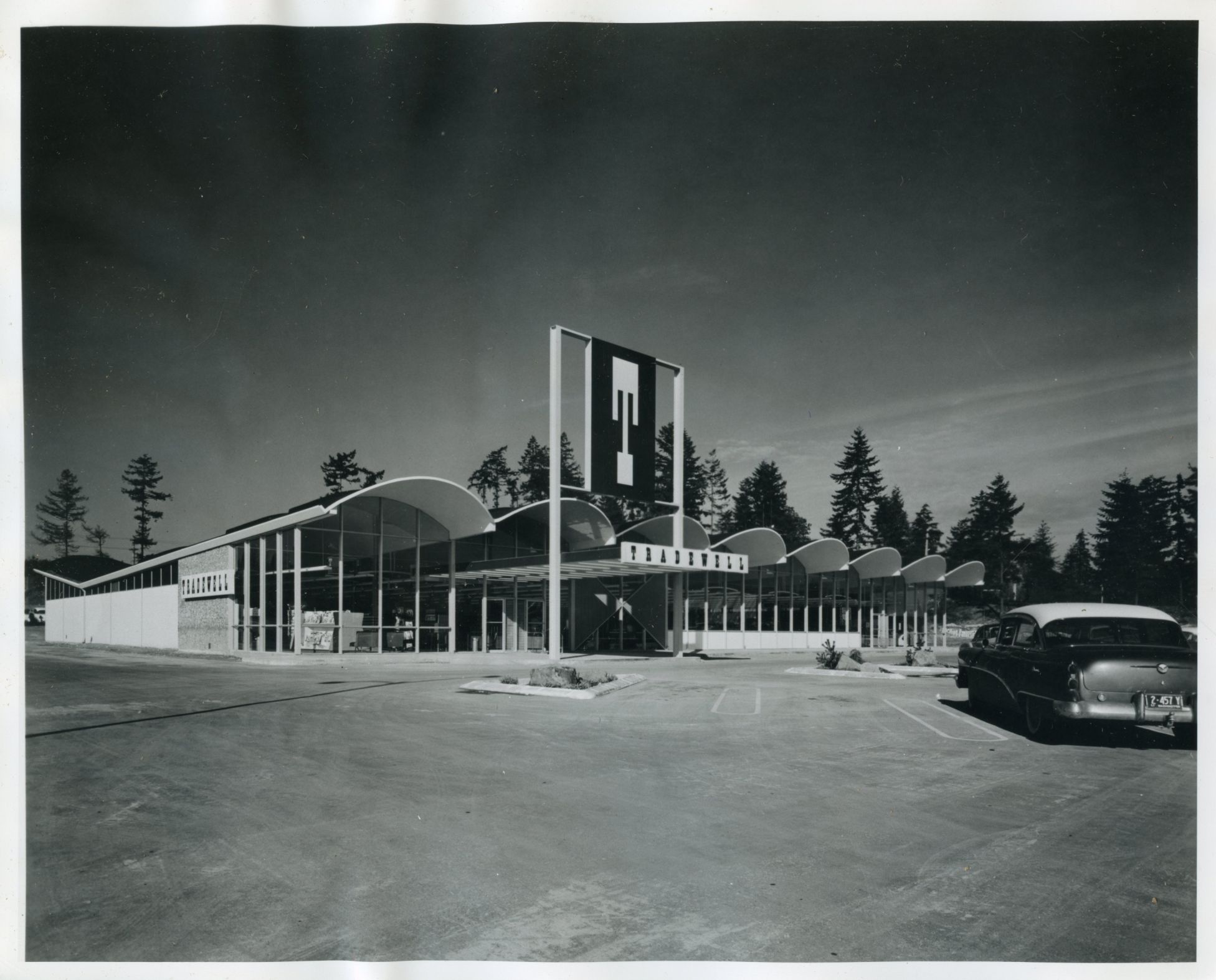
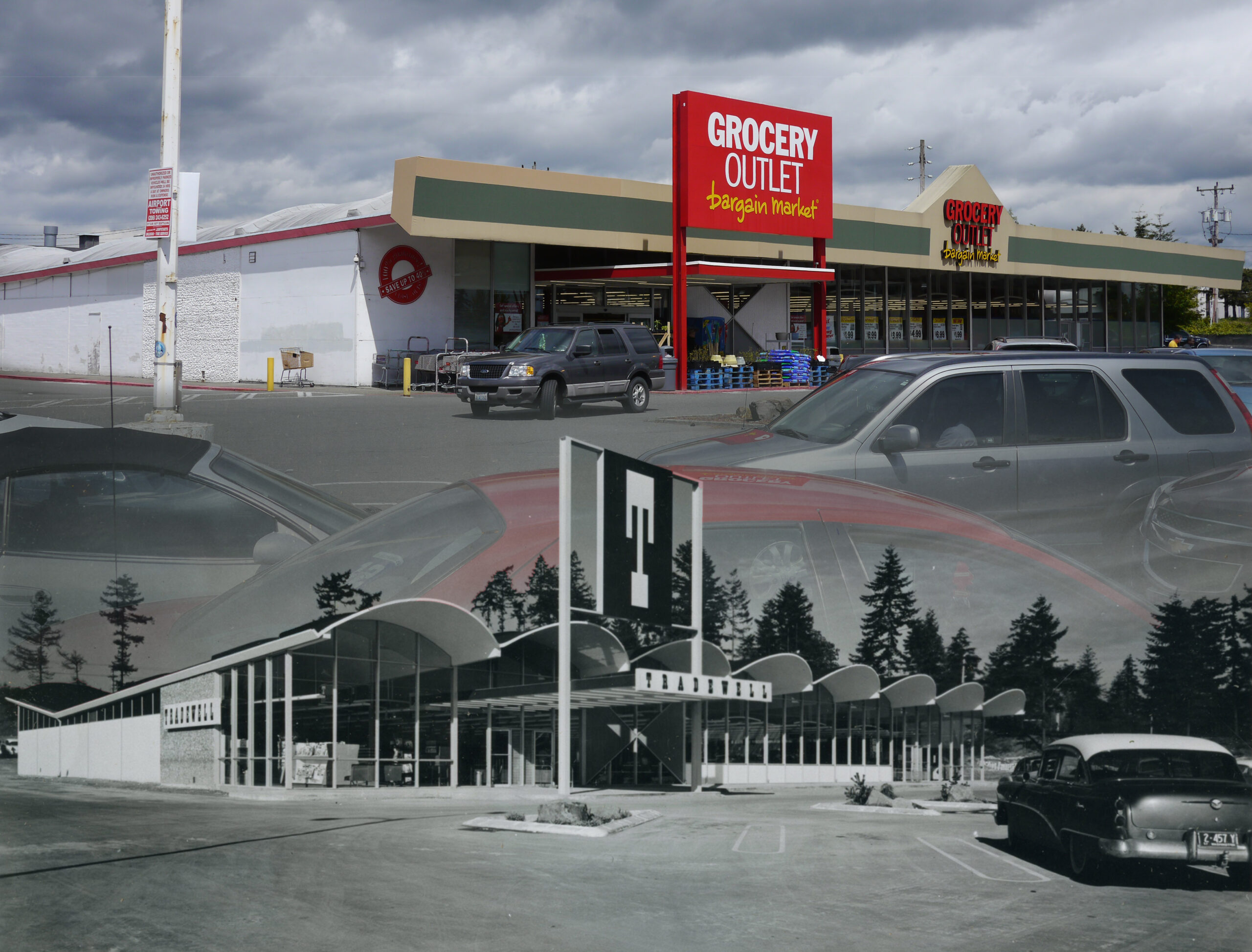
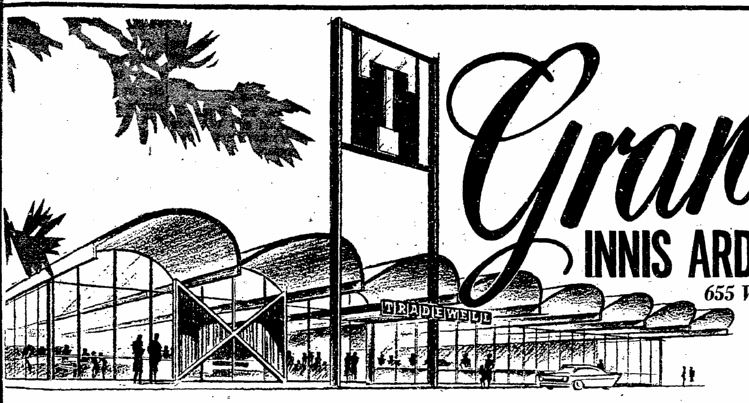
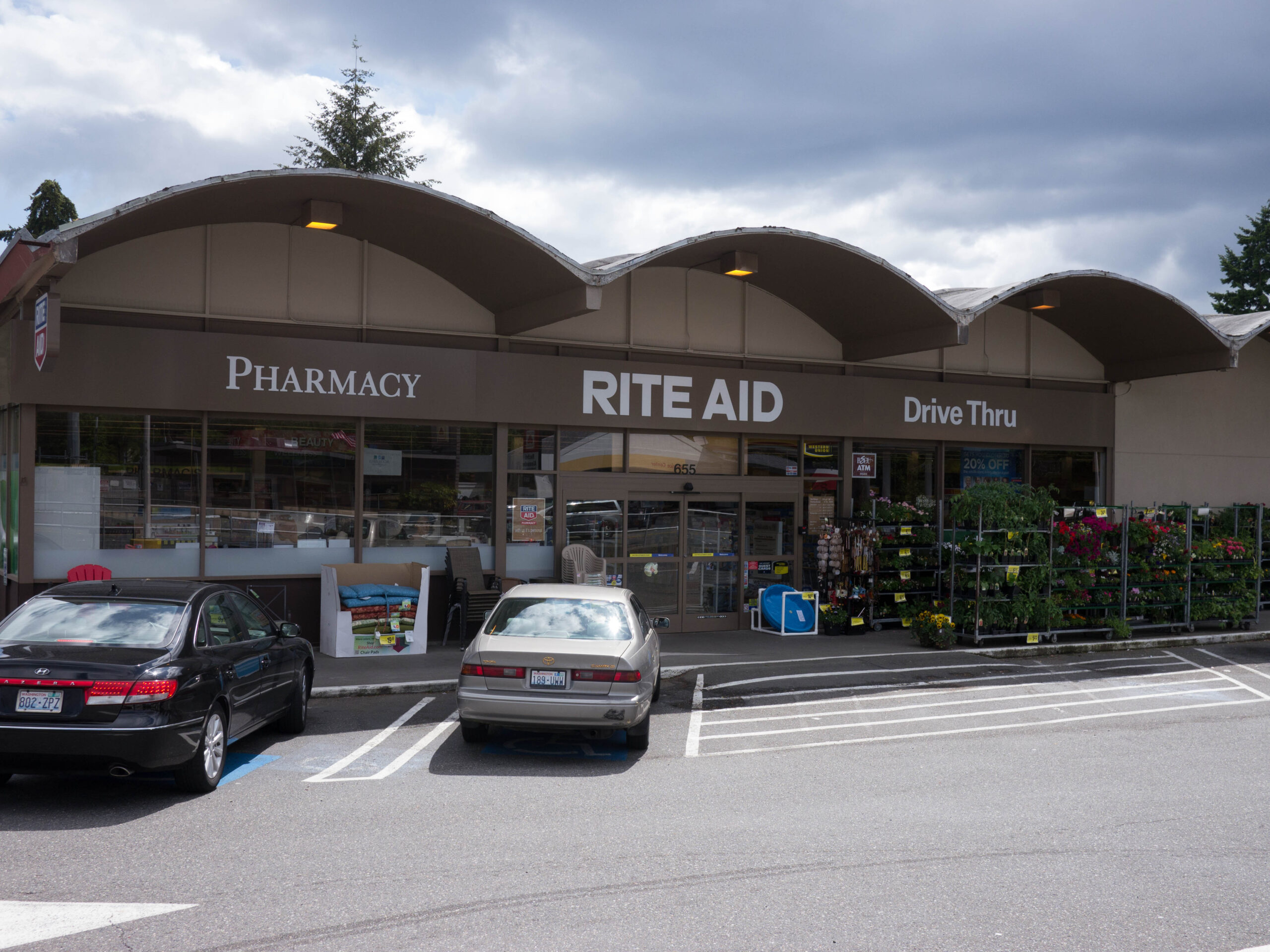
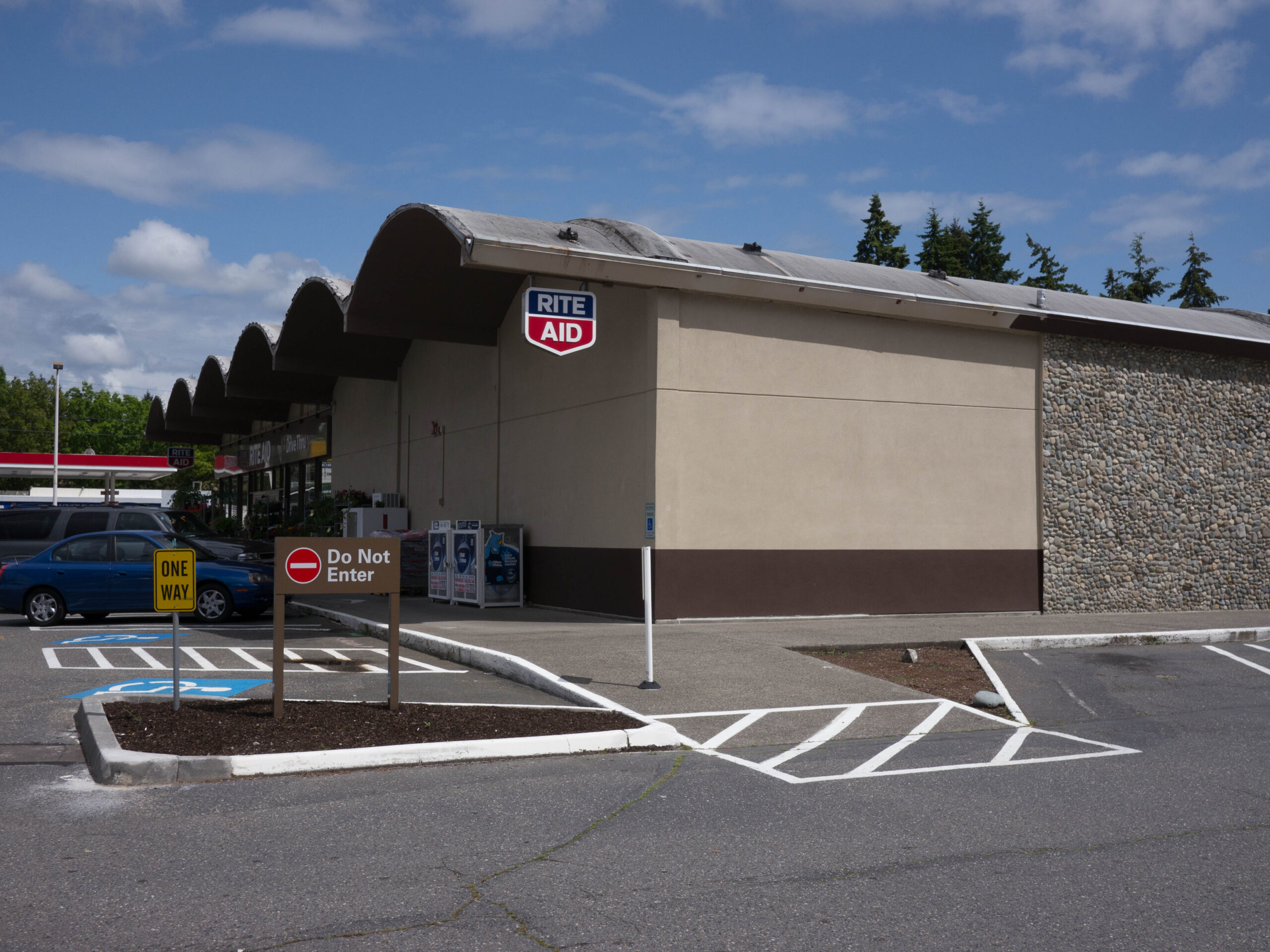
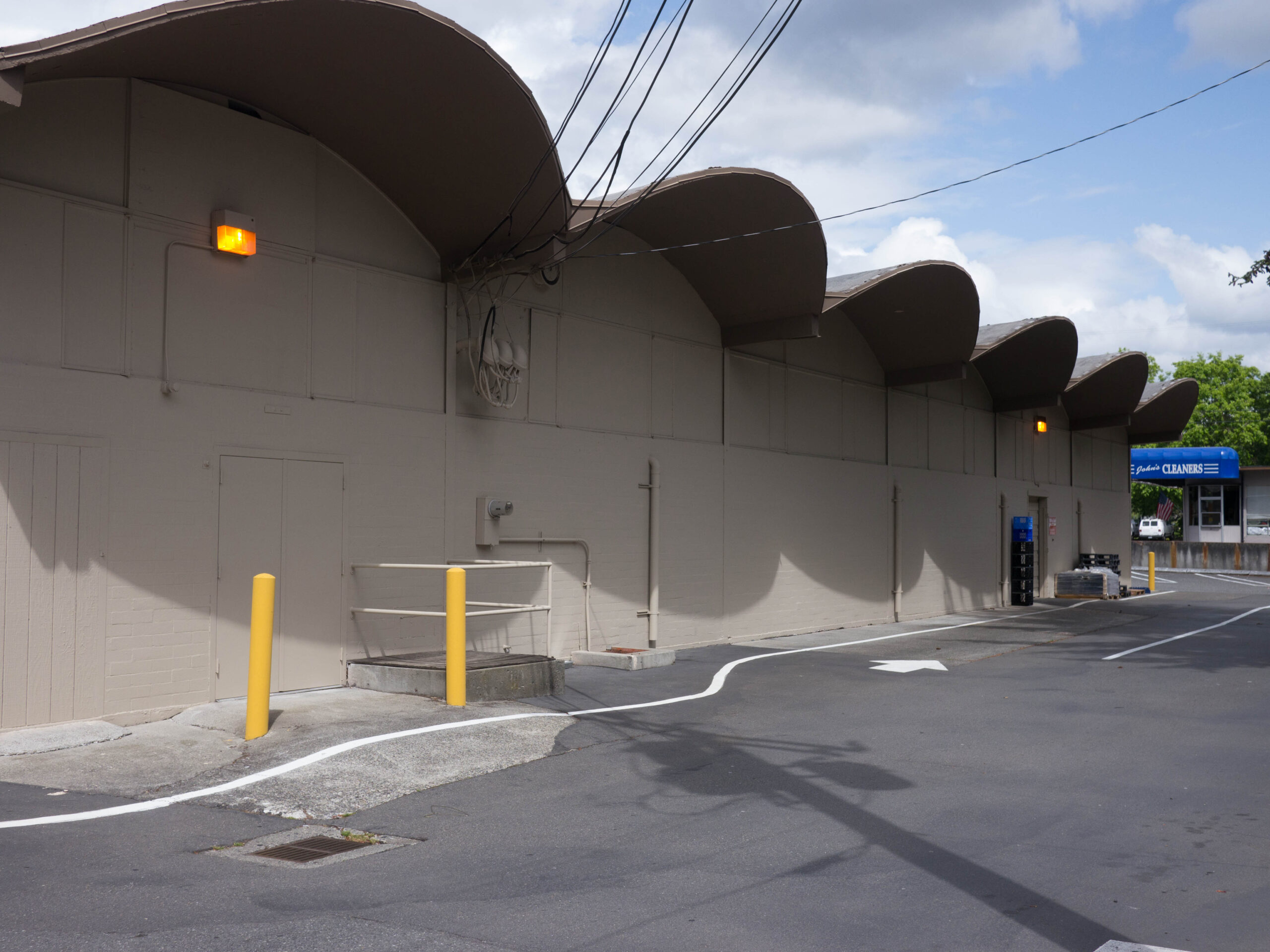
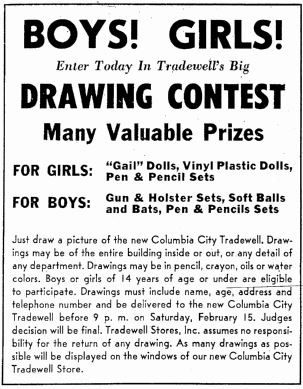

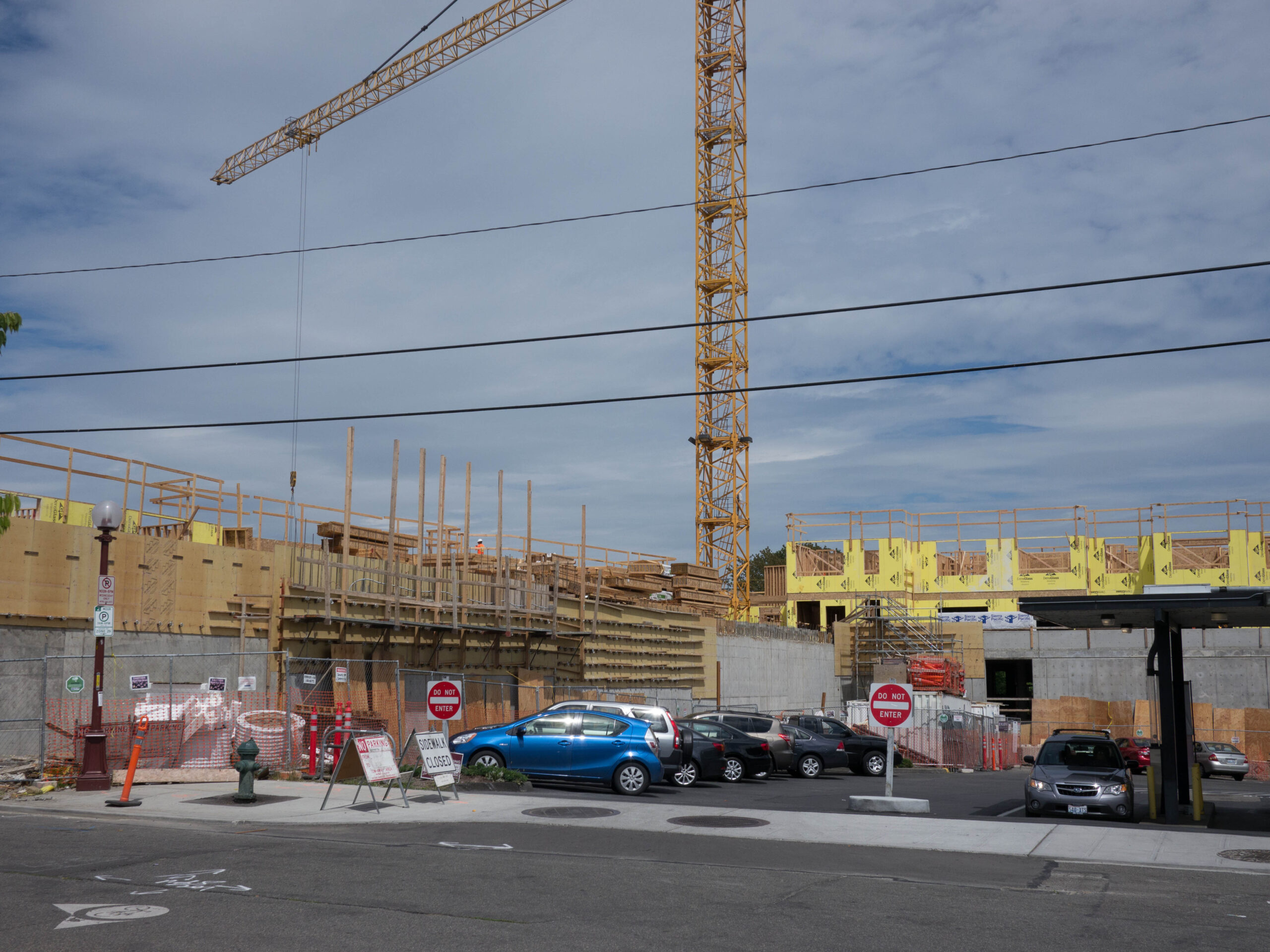

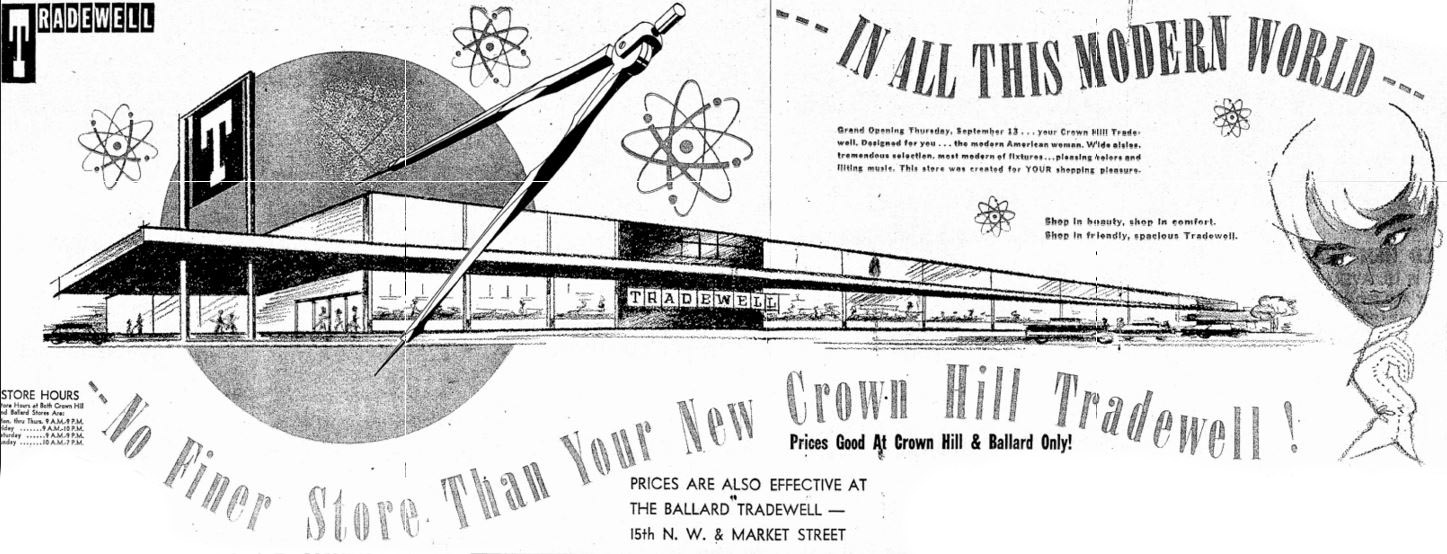

Fascinating story of stuff that the public often overlooks. Got here from one of your flickr photos (you are one of my flickr contacts).
Thank you! I think we have been following each other on Flickr for a long, long time! I love your work.
I currently live in West Seattle and had grown up in the White Center and Burien areas, so this is very interesting to me! But while I know that both the White Center and Burien stores that you mentioned were indeed Tradewell stores, I only remember seeing them as Prairie Market stores. You probably know that they were the warehouse store division of Tradewell. Also worth noting, but before Pacific Gamble Robinson sold Tradewell to their store managers, they started reimagining Tradewell into a small but more upscale chain. In fact, I remember seeing later Tradewell ads saying that a “new” Burien Tradewell was coming. That would have converted the Prairie Market back to Tradewell. Also worth noting, the current Dollar Store adjacent to the Burien Grocery Outlet, started out as a Pay n Save. Then it bacame Bartell Drugs. Pay n Save ended up moving to the property where there was also a Pay n Save owned Lamont’s store.
There were at least two other Tradewell stores from the period that are not mentioned here: Mercer Island and Ridgecrest (5th Ave at about 165th, near the Crest Theater). Our father opened the Mercer Island store as manager (after managing several Tradewell stores around town, the previous store being the one at the corner of 23rd and (E.) Union) in the late ’50’s and the Ridgecrest store was about 2 miles from our Shoreline home. Do you know anything about the opening dates of those stores?
Richard, thank you for your comment! I hadn’t taken a close look at the Mercer Island yet. It opened December 1, 1955.
It was designed by Seattle architects Decker & Christianson. They also designed the Bellevue store that opened around the same time as Mercer Island.
Tradewell was iterating quickly on designs. Drawings and photos from the opening show it with a massive T-shaped sign that had the word “Tradewell” on the top bar. The Burien store was obviously a progression on ideas of light and transparency that were already in play in 1955, based on descriptions of the opening written by Tradewell marketing.
Two interesting designs in the South end would be, I think it was the “Market Giant” at 154th St So and Pacific Hwy, which had a Drug store next to it that had an honest to goodness real Soda Fountain in it!
Also, what seemed to be a somewhat copy of the Tradewell design, was the combined building that housed the Market Basket and G.O. Guy Drugs, next to the Lewis and Clark Theatre. It’s rounded roof design looked a lot like the Tradewell design! It is still there, but repurposed into serving the Car Rental company That now owns it. By the way, it’s too bad they demolished the Lewis and Clark Theatre and Bowl! The Theatre was one of the largest in the Seattle area, with an upper and lower deck seating. It’s really too bad, because the side walls on the inside had Murals of Lewis and Clark’s Expedition Of Discovery, which was totally unusual for a Theatre! It also had a baby room behind a Glass wall, at the top of the Upper Deck, so that Mother’s who had noisy babies could go there, watch and listen to the Movie, and not disturb the other Guests! Now, who wouldn’t want that Today! And I even more places than just the Theatre! I remember seeing “A Hard Day’s Night” there in 1964. And before the movie started, the Movie Complex Manager came out and said, “If you kids can’t be quiet during the Movie, I’ll shut it down!”. Which came, of course, from the screaming girls, who attended many Beatles events and concerts. Funny!
Rob, I just saw your book at Costco, and will have to get it!
There are two remaining Tradewell buildings in Everett. One is at 20th and Broadway and currently houses Erickson furniture. The scalloped design was only part of the front facade of the building. The building has a flat roof. The front scallops have been covered but you can still see them if you’re on the sidewalk in front of the store. There are remnants in the concrete of where the two entrances were. There is a very very tall sign out in front that used to have a big T on it which now has a big E on it. Although the two giant girders only take up a couple of square feet each, the sign has its own City tax number.
The other building is at 49th and Evergreen way. After it was a Tradewell store it became a Pay n Save and ended up with an Ernst store next door. It is now a Rite Aid store.
I hope you get this and all is well with you. Nice work on the articles.
My mother was hired as one of the first meat wrappers for the new Tradewell store that opened in Kenmore circa 1957-58. The Tradewell building was NOT demolished and is now home to Rite-Aid Drugs.
I can fill in some with what Cathy Doser wrote. Back in the 70’s as a young man I worked at both the Lewis & Clark Theater and the Tradewell across the parking lot. That Tradewell was originally an Art’s Food Center when I started there as a box boy and was bought out by Tradewell around 77′ I believe. I did it all in that store – and some of the surrounding Tradewells too… like West Seattle, Rose Hill, Kent as I was working on my I/T degree. I eventually got a job in the main office in Kent as a computer programmer. One of my first tasks was to write a program to remove duplicate names from the mailing list for Prairie Markets. Back then the store would put out a really good coupon once a month for something free or very low cost. People would make slight alterations to their name or address to get multiple coupons. My program had to identify them all as the same individual and remove the duplicate entries so they’d only get one coupon a month. Some people had over 20 entries! My program cut the mailing list by almost 20% (a LOT of people were playing games to get extra coupons!). Must have saved the company tens of thousands of dollars a month… not bad for a rookie programmer!
You may know too of the Richmond “Beach” (it’s closer to 99 than to the Beach) TRADEWELL of ca 1957. May have opened in Oct 57, I need to doublecheck. This wonderful architecture remained largely intact until recently. Great ads help however,in the Seattle Times, perhaps. Copies of the ads were once posted at Shoreline Historical Society.
I just got better reception on the screen I was using. You DID cover Innis Arden/Richmond Beach, beautifully! Thank you!
Allow me to add another story about the demise of Tradewell. As I mentioned above, I worked in the stores in the late 70’s while getting my I/T degree and subsequently moved to the main office in Kent as a computer programmer. In 83” Tradewell lost about 2/3rds of their I/T staff over just a couple of months in a mass exodus during a very critical time when they were in a major project to computerize their warehouse operations with computerized picking/sorting and transport to the right truck via bar codes and automated conveyor belts, etc. Cutting edge technology at the time.
At the time I/T workers were in BIG demand in the Seattle area and salaries were rising quickly and Tradewell wasn’t keeping up with raises.. Eventually salaries were something like 20% under current market rates. We programmers, as a group (about 20 of us) set up a meeting with the VP of Finance to make a case for higher salaries. Charts were shown, survey results provided, etc. in our presentation. After the presentation, this VP looked at us and essentially stated that as far as he was concerned we were already OVERPAID because all we did was “type all day just like the secretaries” and yet made more than them!
Well the writing was on the wall – no future as an I/T person… we were just “people who typed all day” in the eyes of the VP. Over the next 2 months Tradewell lost about 2/3rds of it’s I/T staff. The warehouse project which was mid-completion was delayed and had huge cost overruns for contract programmers, etc.. The Point of Sale systems which I handled had to contract with IBM for about $20K per month for support. The impacts must have been felt everywhere. I heard the VP got canned over it, but can’t confirm that. I think they ceased operations within a few years of this. To this day, I’ve never seen such a major blunder regarding staffing.
I stumbled onto this post about Tradewell and wanted to fill you in on Tradewell in the Tacoma area. Tacoma had several, including one on 6th Ave, but it was an older store, pre 50’s I think. Anyway, there still is a barrel arch store building on Bridgeport Way in University Place as I’m doing research for a video project on it for my YouTube channel.
I decided to find when Tradewell came to be to give a brief info on the store and stumbled onto this article.
The store sits at 27th and Bridgeport Way and currently houses several business, including an Autozone that still has the thin cast concrete arches and it’s still present outside the building, but was a Tradewell, I think it was built in 1960. We had an older Safeway, opened in 1961 that was built on 27th St W (since torn down and a Bartel Drugs was built, now moved to James Center and the former Rite Aid store there).
I have 2 archive photos of the old Tradewell stores to use in my project that I found through the Tacoma Public Library’s NW room online archives.